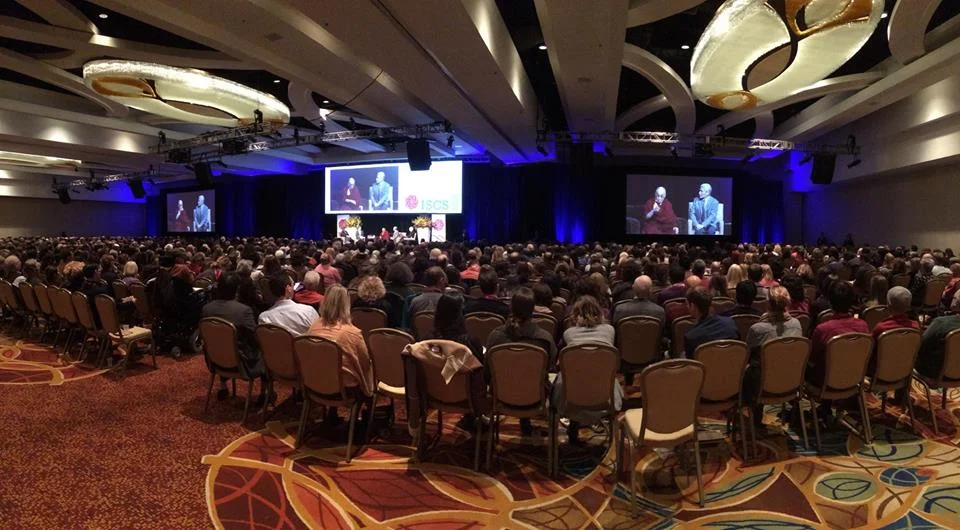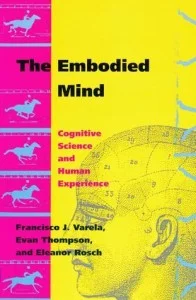The rise and rise of contemplative studies
This weekend, I was at a conference in Boston called the International Symposium on Contemplative Studies. I know - sounds pretty niche, maybe two monks, a chakra healer and a shaman with maracas? Well, it was enormous - 1600 people, 300 presentations, including ones by some of the leading psychologists in the world, and the Dalai Lama.
It was epic - fascinating presentations, free yoga and meditation sessions every morning, Sufi poetry, Qi Gong dancing, and a lot of unusually impassioned and warm academics. 'What journey brought you here?' one lady asked me as I stood in line for registration. Well, er, Virgin Atlantic if you must know.
The field of contemplative studies is still pretty new in the US (it barely exists in the UK). It first emerged in the 1970s, when a handful of scientists started to study and practice Buddhism and yoga - including the biologist Francisco Varela, the neuroscientist Richard Davidson, and the psychologist Jon Kabat-Zinn. They founded something called the Mind and Life Institute 27 years ago, based on small-group dialogues with the Dalai Lama and other Tibetan monks. Two years ago, it began to hold much bigger public conferences - this is the third.
‘It was pretty lonely in the 1970s, there were only around 10 of us’, Davidson remembers. ‘We were the lunatic fringe’, recalls Kabat-Zinn. He invented the Mindfulness-Based Stress-Reduction course (MBSR), an eight-week course in mindfulness and yoga, which he and others then proved was clinically beneficial for a whole host of emotional and physical problems. Davidson, meanwhile, used brain-scans of monks and new practitioners to show that meditation changed the physical structure of the brain. In the UK, Mark Williams and John Teasdale of Oxford developed mindfulness-based CBT.
These pioneers helped to create the contemporary boom in mindfulness, which has spread to schools, universities, hospitals and therapy centres, the military, prisons, companies and beyond. Back in 2007, a survey by the National Institutes of Health found that 10% of Americans had tried meditating - it has grown a lot since then. ‘I get the feeling it really exploded this year’, says Francis McKay, a University of Chicago anthropologist studying the rise of mindfulness.
Among other things, contemplative studies is revolutionizing the 20th century model of academia.
Francisco Varela thought that contemplative studies could combine third-person accounts of consciousness from neuroscience with first-person accounts from phenomenology (by interviewing people about their experiences). Finally, a bridge would be built between science and the humanities, between facts and values, between third-person objectivity and first-person subjectivity. It was a new model for the academic, grounded in wisdom practices, which would create a new, secular, evidence-based ethics for the modern world.
This strikes many in academia as heretical. There is a belief in academia, which arose in the late 19th century, that academics should be rigorously objective, which means they should suppress their own views, biases, preferences, and moral and metaphysical beliefs. The sociologist Max Weber summed it up well in his lecture Science as a Vocation: academics should critically investigate, and resist the temptation to preach to their students from the lectern.
But this means that ancient wisdom practices can be studied, but not practiced. It would have been very strange, 20 years ago, for an academic philosopher to suggest Stoic practices actually work (thankfully this is changing). It’s still anathema in most of academia. I was struck by this when I went to a seminar on Christian mystics earlier this year. Not one of the participants ever discussed if they had tried out contemplative practices for themselves to see if they were true. That would be weird, or ‘unobjective’. The first-person perspective must be ruthlessly suppressed.
The result of this false dichotomy, alas, is a moral vacuum in the humanities, combined with an ever-greater reverence for the hard certainty of the sciences.
Some prominent figures in the humanities have called for a more explicit promotion of virtue ethics in the university, including Nigel Biggar of Oxford and Baroness Onora O’Neil, both of whom I saw speak on this issue last month. But they had no practical idea of how actually to promote virtue ethics in their students, besides lectures and tutorial feedback on essays (this, they claimed, would promote intellectual virtues like respect for the truth).
This is in the right direction, but not nearly enough. Virtue ethics is based on a deep transformation of one’s core beliefs, emotions and habits. Ten minutes of essay feedback once a week, or more likely once a term, simply won’t do it. It won’t scratch the surface.
I was acutely aware of this while at Oxford, where I got a first in English despite suffering from PTSD and social anxiety. It is perfectly possible to be a successful humanities scholar while also being a complete moral and emotional mess - this is as true of academics as undergrads.
When Plato founded the Academy, 2400 years ago, it was designed both to create reliable knowledge about the world, and also to promote wisdom about the self. That involved not just teacher-feedback, although there was a lot of that, but also contemplation and ‘care of the soul’ - this was at the core of the Academy. Likewise in Aristotle’s Lyceum - Aristotle thought theoria, which originally meant contemplation, was the highest good for man, and was necessary for all the disciplines, from ethics to politics to metaphysics.
Likewise in the Stoic school: ‘We may be fluent in the lecture-room’, warned Epictetus, ‘but take us to practice and we’re miserably shipwrecked.’ The early proto-universities of the Middle Ages were also places where third-person objective research was combined with first-person contemplative practice - a good example is the Abbey of St Victor’s in Paris, where a broad liberal arts curriculum included contemplative practices at their core.
Now, thankfully, there is a revival of the study and practice of wisdom in academia - and it was championed not by the poor, cowed humanities scholars, but by psychologists, who rediscovered the therapeutic wisdom of ancient Greece and Asia, and thought, let’s try it out, test it, and then disseminate it to the general public. Thank God for their pragmatism.
This revival of ancient wisdom is transforming medical education. Jon Kabat-Zinn started researching mindfulness at U-Mass medical school in the 70s. Today, 33 US medical schools have mindfulness research centres, and many more provide mindfulness courses for students, staff and patients.
The more doctors practice meditation, the more they understand the connection between the mind and the body. That’s transforming medicine, and will helpfully lead to a shift from a narrow biomedical model, in which any physical or emotional problem are treated with drugs, to a more holistic model that incorporates wisdom practices.
It’s also transforming life for the average undergrad. I suffered in silence throughout my time at Oxford. Today, students can get free mindfulness courses, thanks to the Oxford Mindfulness Centre run by Mark Williams, which pioneered mindfulness-CBT. Earlier this year I interviewed Mary, a seminary student at Oxford, who learned to heal herself through PTSD thanks to free mindfulness training.
At some US universities, ‘contemplative studies’ is not merely a wellbeing add-on, but part of the main curriculum. Brown University launched a ‘contemplative studies’ curriculum course this year, in the face of strong institutional opposition. ‘The most hostility came from the Religious Studies department’ remembers one academic from the programme. ‘They thought it would undermine objectivity, it would lead to Sunday school sermonising.’
Potentially, contemplative studies could transform many disciplines, not just medicine. Both Brown and Virginia's new contemplative studies centres, for example, are interdisciplinary and bring in the arts and humanities. At the conference, there were presentations by physicists on using contemplation of nature in their work; architects on how buildings can trigger contemplative states; literary critics on the poetry of Blake and Emily Dickinson as an exploration of consciousness; economists on contemplation as a part of well-being economics; musicologists on drumming and trance states, and so on.
The big hope, at the conference, was that ‘contemplative studies’ could actually provide a new ‘secular ethics’ for the world, and help us through the enormous political challenges we face. ‘There are one billion non-believers in the world’, the Dalai Lama said. ‘They won’t listen to a monk talking about inner values, but they might listen to scientists, if they prove a connection to well-being.’ He’s right - mindfulness has become sort of a secular ethics for a happiness-obsessed modernity.
Challenges for the field
But there are big challenges for contemplative studies. I’ll outline five:
Firstly, there is a limit to what can be measured empirically. Contemplative studies, like Positive Psychology, hopes that science can measure how to make someone more virtuous, more humble, more compassionate and so on. But this is not that easy. As the Dalai Lama put it: ‘To know what’s in a person’s heart you need clairvoyance. Or you need to spy on them closely for, say, a year, to see how they behave.’ ‘That’s easy in a monastery, less so in a psychology lab.
A second challenge for this new ‘secular ethics’ is whether ancient wisdom practices can be simply ripped out of their original context and brought into secular modernity, without important stuff being lost. This is as true for Stoicism as it is for Buddhism. ‘Whatever works’, said the Dalai Lama, and there’s something in that, but ethical practices can easily become instrumentalized, demoralized and hijacked by capitalist culture.
A third risk for contemplative studies is that academics lose their objectivity. They get high on their own supply. Academia becomes what it often was in the Middle Ages - dogmatic, culty. It over-hypes its product. I wonder if this has been the case at the Maharishi University, which produces reams of research on the benefits of Transcendental Meditation (it lowers blood pressure, it reduces crime, it stops wars), but hardly any research that’s critical of TM or its founder Maharishi Yogi (peace be upon him).
It was a little weird when the entire hall stood up in reverent silence for the arrival of ‘His Holiness’, and how senior psychologists like Paul Ekman told us how ‘His Holiness instructed us to explore’ this or that research area.
Brown’s contemplative studies centre looks more hopeful in this respect. It is working on a controversial project originally called the Dark Night project, now renamed the Varieties of Contemplative Experience, which explores the difficult experiences people can have in meditation - the return of repressed feelings or memories, insomnia, involuntary physical twitches, depersonalization, loss of self (this can be very scary) and even psychosis and hospitalization. Sometimes these negative experiences lasted for several years.
‘The western media promotes a narrative that mindfulness is a miraculous panacea for health and well-being, while ignoring what contemplative texts say about the very difficult experiences that are often part of the journey’, says Willoughby Britton, a psychiatrist who runs the project.
Fourth, the field of contemplative studies needs to widen beyond its narrow focus on Tibetan Buddhism. The biggest elephant in the room at the conference was that it almost entirely ignored western contemplative practices, besides a couple of fringe sessions by junior academics.
Tom Coburn, former president at Naropa University and a key figure at Brown’s contemplative studies centre, says: ‘Sooner or later, contemplative studies needs to deal with the fact that most contemplatives are theists. Most contemplative studies academics are probably agnostics, who rejected their Judeo-Christian background.’
It has been relatively easy to fit Tibetan Buddhist or Stoic practices into a secular, materialist context - you just leave out a lot. ‘In twenty years we have never spoken about reincarnation or the survival of consciousness after death’, the Dalai Lama said of his dialogues with the Mind and Life Institute.
That’s not a bad thing - it’s enabled meditation to help a lot of agnostics and atheists who were suffering. But it’s much harder to secularize and naturalize when it comes to theistic contemplative practices. I wonder if the field will eventually move towards a multiverse theory of spiritual realities - this is where William James, one of its founding fathers, ended up.
Finally, how do you make sure that contemplative studies does not become too inward-looking, that it does not become a bunch of ‘navel-gazers’ - the traditional insult for contemplatives.
In fact, it was obvious that the western academics of contemplative studies bring a very Judaeo-Christian emphasis on ‘saving the world’ to Buddhism. Contemplation, we heard, can save humanity from capitalism, from climate change, from extinction. In this sense, it is genuinely something new. In Buddhism, as in Stoicism, the world does not need to be saved.
For a western perspective on integrating ancient wisdom into modern life, come to the Stoicism Today conference at Queen Mary, University of London on November 29. Tickets here - much cheaper than the ISCS!






